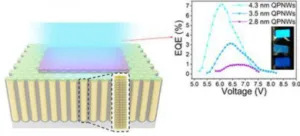A team of researchers having affiliations with a number of institutions and led by Yu Fu of the Department of Electronic and Computer Engineering, The Hong Kong University of Science and Technology, (Clear Water Bay, Kowloon, Hong Kong) are developing a novel technique to fabricate perovskite-based LEDs (PeLEDs) using a technique called quantum confinement.

To start, a few words of background information.
In PeLEDs, color tunability can be accomplished by adjusting the composition of the iodine, bromine and chlorine halide materials used in the composition of the device. Unfortunately, mixed halide PeLEDs are often susceptible to red shift color instability caused by migration of ions and separation of the blended halides.
A strategy for addressing this issue is to use perovskite-based nanostructures in conjunction with quantum confinement.
One definition of quantum confinement is the spatial confinement of electron-hole pairs (excitons) in one or more dimensions within a material due to the confinement of the electronic wave function to the physical dimensions of the particles.
The specific quantum confinement approach investigated by the team was based on the use of strongly quantum confined perovskite nanowires (QPNWs).
A recent article on this topic by the team is entitled “Strongly Quantum-confined Perovskite Nanowire Arrays for Color Tunable Blue Light-emitting Diodes.” The article was published on May 6 in ACS Nano. A copy of the article is available for purchase on-line and can be found here.
A somewhat technical description of the approach investigated by the team was paraphrased from this article and is as follows.
An anodic aluminum oxide template assisted single step closed space sublimation growth technique was used to cultivate CsPbBr3-based quantum confined perovskite nanowires arrays in the anodic aluminum oxide templates. Usng this method, the average width of the perovskite nanowires could be carefully controlled. Arrays of these nanowires having various diameters were made into perovskite-based LEDs. By this means, it was possible to produce devices with a variety of photoluminescence emission wavelengths. The authors explain that this effect is an indication of significant quantum confinement.
Some of the results obtained from evaluating the performance of these test devices and reported in the article were as follows.
When the width of the CsPbBr3 QPNW was reduced from 6 nm to 2.8 nm, the peak of the photoluminescence emission color shifted from green (512 nm) to pure blue (467 nm). One sample produced a cyan color (492 nm) and achieved an external quantum efficiency (EQE) of 7.1%. To the team’s knowledge, this is the highest EQE ever reported for a completely pure CsPbBr3-based cyan blue light emitting LED.
In addition, sky blue (481 nm) and pure blue (467 nm) quantum confined perovskite nanowire LEDs were successfully produced to demonstrate the viability of controllable emissions in the blue range of the spectrum. In these PeLEDs samples, 3.2 percent EQE was measured in the sky blue sample and 0.9 percent EQE was measured in the pure blue sample.
The figure below illustrates the structure of a QPNW based tunable blue emission PeLED. Included in the figure is a graph of the EQE as a function of voltage for three QPNW widths.
 A quantum confined perovskite nanowire-based tunable blue emission PeLED.
A quantum confined perovskite nanowire-based tunable blue emission PeLED.
The team concludes their article with the statement that their research demonstrated the potential of quantum confined perovskite nanowires for high performance yet reliable full color perovskite-based LEDs. – Arthur Berman

